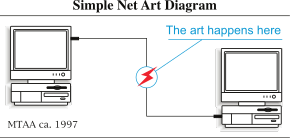
Back فن الإنترنت Arabic Интернет изкуство Bulgarian Netzkunst German Διαδικτυακή τέχνη Greek هنر اینترنتی Persian Art en ligne French אמנות אינטרנט HE Internet art Italian インターネットアート Japanese 넷 아트 Korean

Internet art (also known as net art or web art) is a form of new media art distributed via the Internet. This form of art circumvents the traditional dominance of the physical gallery and museum system. In many cases, the viewer is drawn into some kind of interaction with the work of art. Artists working in this manner are sometimes referred to as net artists.
Net artists may use specific social or cultural internet traditions to produce their art outside of the technical structure of the internet. Internet art is often – but not always – interactive, participatory, and multimedia-based. Internet art can be used to spread a message, either political or social, using human interactions. Typically, artists find ways to produce art through the use of the internet and the tools that it provides us with.
The term Internet art typically does not refer to art that has been simply digitized and uploaded to be viewable over the Internet, such as in an online gallery.[1] Rather, this genre relies intrinsically on the Internet to exist as a whole, taking advantage of such aspects as an interactive interface and connectivity to multiple social and economic cultures and micro-cultures, not only web-based works.
New media theorist and curator Jon Ippolito defined "Ten Myths of Internet Art" in 2002.[1] He cites the above stipulations, as well as defining it as distinct from commercial web design, and touching on issues of permanence, archivability, and collecting in a fluid medium.